
Rodolfo Saénz Valiente (1944-2006) was a cartoonist, animator, film director and teacher who was largely dedicated to advertising animation. Apart from his production in various animated techniques, he was one of the few producers/animators who systematized his knowledge as a professor in several careers related to the area of design and cinematography (some of them taught at the University of Buenos Aires).
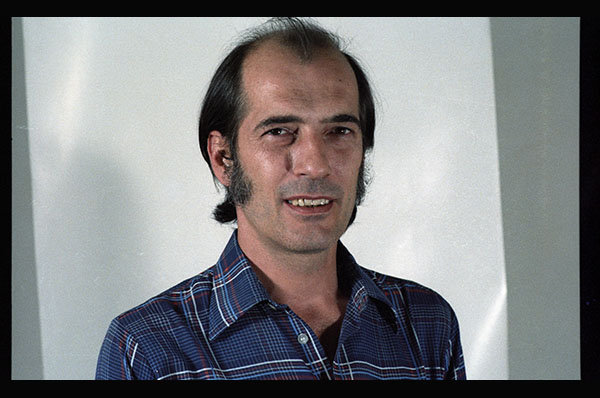
Rodolfo Saenz Valiente

Rodolfo Saénz Valient at work
Rodolfo Saénz Valiente (or Rufo, as he was called) intermittently studied engineering and that explains his talent in the field of construction: the drilling machines and animation guides he built are still in operation, and in his old studio in the Palermo neighborhood there is still a gigantic animation stand, worthy of Dr. Frankenstein, which his son jealously preserves.
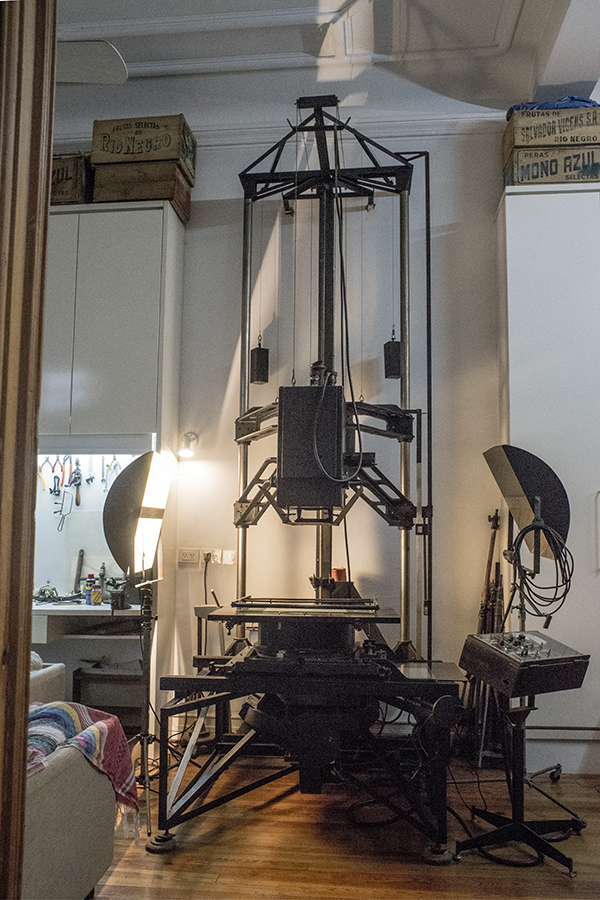
Animation Stand, by Saénz Valiente
At the age of 15, Rodolfo set up a photographic studio on his own, complete with laboratory and everything. From there he expanded his activities to commercial drawing and then to audiovisual production. Then he began to study “Audiovisual Experimentation” at the Di Tella Institute, while he started in graphic design; animated drawing was the next step.
Just as García Ferré’s purely advertising stage accounts for the 50-60’s generation, and Catu’s flourishes between the 70’s -90’s, Saénz Valiente, at the head of his production company Prisma, is a good summary of the “80’s generation”, which made the transition from traditional methods (our man was a devotee of the “do it yourself”) to the digital technologies of the early 2000’s.
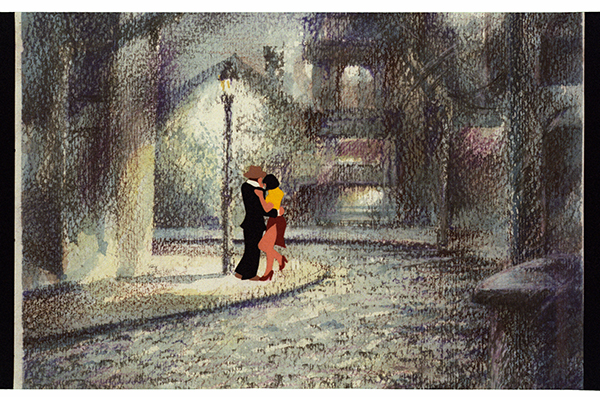
Throughout his career as an animator, Saénz Valiente tried practically all techniques, achieving an important place in the market (“If you don’t know how to do it, call Saénz Valiente”). He did not always focus on commercials: he also produced documentaries and title sequences for feature films, as well as short films for TV with classical and puppet animation. His main contribution may have been in the field of teaching. Few are the Argentine animators of the last generations who did not pass through his hands. Those of us who did not, still use the knife to eat peas.

Buitoni:
Nesquick:
Sistema Previsonal Integrado:
Stop Motion:
El Economista:
Terrabusi:
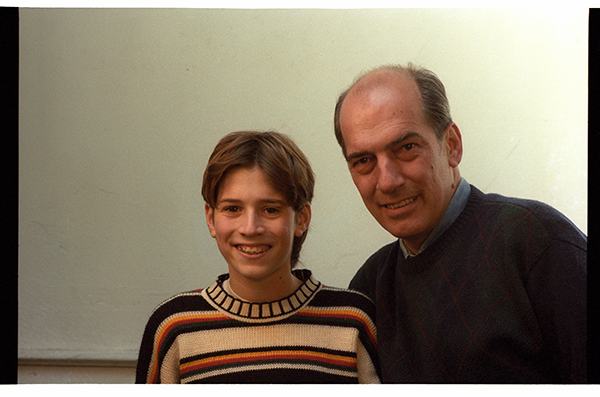
Rodolfo and Juan Saénz Valiente.
Interview with Juan Saénz Valiente:
-Where does your father’s connection with animation come from? Did he have any links with comics, like you?
As a child, my father established a bond with the Pfeiffer’s, a French family upstairs. They had a lot of French-Belgian comics; not very popular by then in Buenos Aires. By the other hand, he started working as a photographer at 15. A friend got him a job to make an audiovisual for a company training course, which led him to be hired for other similar jobs. That’s how he ended up doing more than 500 illustrations for five audiovisuals. All of it showed some of that Franco-Belgian spirit that he had suckled from the Pfeiffer’s.
A little later, he began a career in Engineering, which he left and resumed several times. Thus photo and illustration merged with audiovisuals and later with graphic design, and this was followed by doing stands for exhibition pavilions and cinema. Moving in all these fields, he had made a few attempts at animated films. The click came when he discovered the National Film Board of Canada. Maybe Victor Iturralde (an icon of film teaching in Argentina) had something to do with it; he later became his assistant at the university. The paradox is that all the technical background that he had accumulated, exploded when he discovered the organic work of Mc Laren, the meticulousness of Jaques Drouin’s pinscreens, or René Jodoin’s work. In short, my father discovered that he could put all his research and passion for technics at the service of animation.
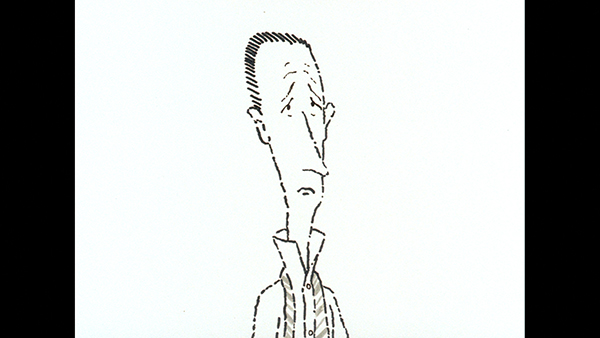
Animators usually enter the world of animation by drawing backgrounds or painting cels in a studio, and they end up animating. My father had a different approach. He started making title plates for commercials. That’s how he founded Prisma Audiovisual, and this led to animated titles, and finally cartoons. He then started with Cristina de Santis Producciones. The company stand out from the rest by using more experimental animation techniques. This allowed my father to experiment and propose new challenges to each client (including traditional cartoon). But his work in animation do not have a strong authorial style at first glance. His range of techniques and styles vary greatly from one work to another.
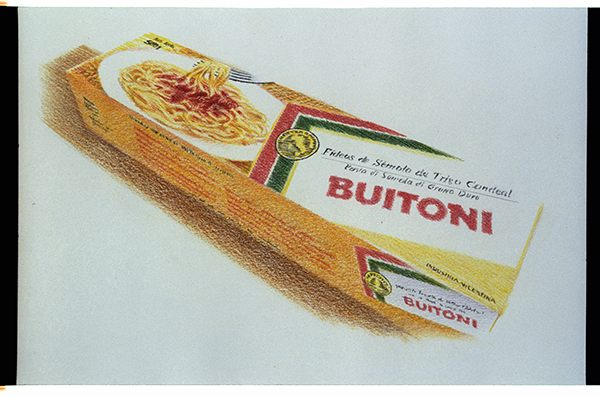
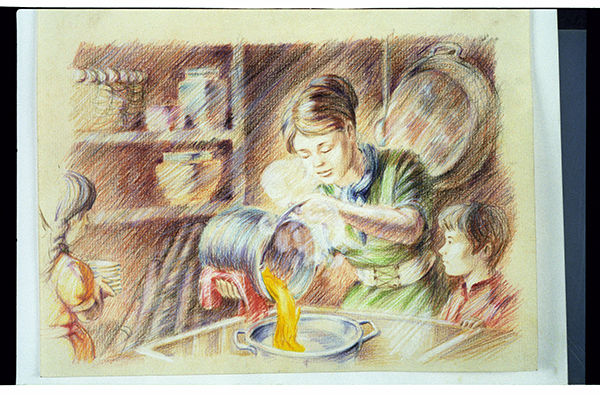
-To what extent did he produce, direct or animate? He overlapped those duties?
As producer he was rather bad. In the case of Cristina De Santis Producciones, the production was in charge of De Santis (who came from Catú). Unlike Prisma Audiovisual, Cristina De Santis focused on animated films. In 1994 the company was dissolved. Then my father launched “Rodolfo Saenz Valiente Cine Animación”, focusing mainly on stop-motion.
In the case of traditional animation, he did layouts, directed and drew the main poses. He also used to do the backgrounds. Depending on the amount of work, he could animate. He always supervised everything and was in charge of filming; a very complex task. He usually stayed up all night and rushed with the cans to the development labs. In the case of stop-motion, he had a set designer, a director of photography, a doll modeler and a cameraman. Rufo made the structure of the dolls, calculated camera movements and animated (sometimes with an assistant if there was more than one doll). As most of the stop-motion animations he did were solo projects, the group and the tasks were quite stable.
Also, at the production level, he had fabricated his own animation stand. To do so, he had ordered the catalogs from the USA pretending to be interested in acquiring one. He had also made the crane for the stop-motion area.
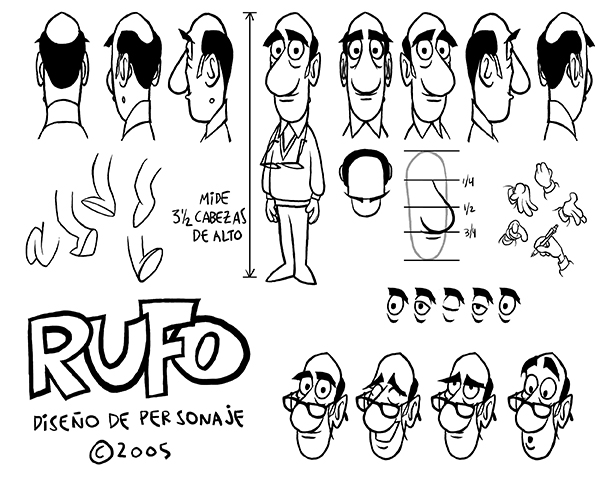
Rufo model sheet, drawn by his son
-Did he work with free-lance animators?
Except for Cristina De Santis in production and a few some others, they were all freelancers, if I remember correctly. In traditional animation, many of them used to be the same: Alberto Grisolía and Carlos Coronel, with cel painter Graciela Geraci. There was also Harald Kimmich, a great cartoonist who did a little bit of everything and helped a lot in the animations that escaped the cartoon techniques.
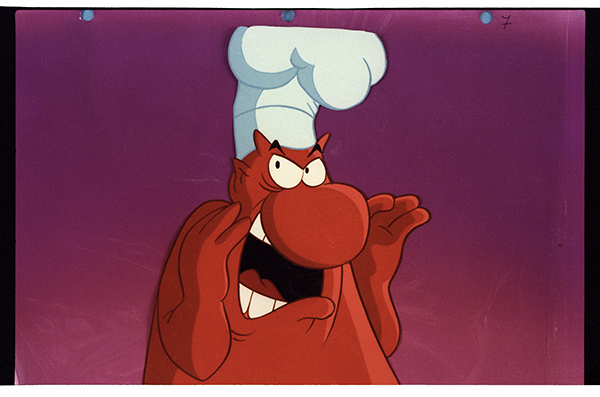
The stop-motion staff was also permanent: Alberto Andreani as DP, Daniel Gihgliazza as set designer, Eduardo Piola in camera, Jonathan Rocotovich as animation assistant and Luciana Fernández modeling of the dolls.

Stop motion project by Rodolfo Saénz Valiente
-Unlike other directors, your father dedicated himself to teaching…
He loved to transmit knowledge. He also loved the public aspect of education. He recruited collaborators for his work from among his students. He was head of Animation in the Image and Sound Design dpt. at the University of Buenos Aires, a career he also created at the Avellaneda Institute of Cinematographic Art. Anyway, when the crisis of the mid 90s came and the production company was dissolved, he turned to teaching as a main task, also at private universities and workshops. Because he had experimented with many different techniques, his background was huge. Usually animation directors focus on a specific technique; but he was keen about any technique proposed by the student, really optimizing his work without imposing a “cartoon-like” school full of stylistic vices.
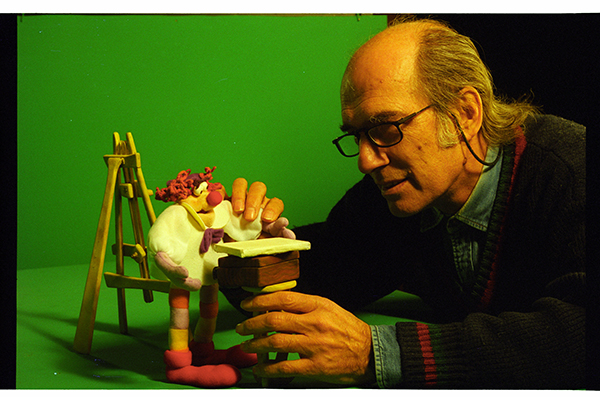
RSV at work
Once Cristina De Santis Producciones was dissolved, Rufo decided to turn to stop motion, with the idea of making a feature film that never materialized. The main reason was that he didn’t have a deadline. All the animation works he had always done were a battle between experimenting and delivering. The feature film project, in terms of animation footage made, never went beyond a test shot of a few seconds. But my father, in order to make it, acquired a lot of knowledge about dolls structure, modeling, camera, lighting and scenery.

Stop motion project by Rodolfo Saénz Valiente
This knowledge was poured into his notes. Which ended up being the animation manual that was later published, a big chunk of more than 650 pages that contains illustrations of a great variety of Argentine authors. He finished the book, but died before the publication. Animation books are usually made by an author who limits himself to cartoon, or stop motion, or CGI, but he tried to cover all techniques. The book has already sold out several editions and continues to train new generations of students in Argentina.

RSV’s book
-How did it influence you in your own work?
I limited myself to drawing. I never managed to develop neither skill nor passion for crafts that involved tools other than a pencil. However, he was also very present in terms of technique. Being me a cartoonist, I guess the Pfeiffer’s influenced my tendency towards the Franco-Belgian market, for which I usually work nowadays, in addition to having recently settled in France.
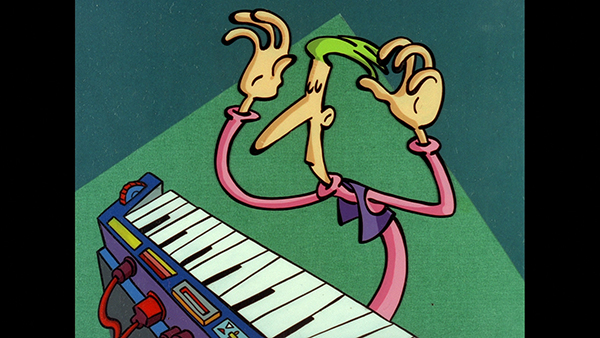
Although I made some attempts (guided by my father) in stop-motion, I focused on traditional animation. In any case, I always had in him a great drawing teacher. He did not impose a limiting style of drawing, offering a wide range of possibilities from the technical aspect. Perhaps he lacked something on the expressive side. But, at the same time, he opened for me an enormous variety of authors and techniques: from the traditional Frank and Ollie’s to Tex Avery, from the sand films of Caroline Leaf to Barry Purves.
Here’s an embed of a Juan Saénz Valiente short:


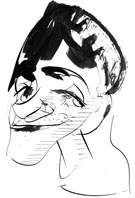 Lucas Nine is an Argentine artist: illustrator, graphic novel author, animator and director of animated films. His work has been awarded several times and published, exhibited and screened in Argentina, Brasil, Mexico, Canada, Spain, Italy, France, Germany, Hungary, Netherlands and Japan. Check out his animation and artwork online:
Lucas Nine is an Argentine artist: illustrator, graphic novel author, animator and director of animated films. His work has been awarded several times and published, exhibited and screened in Argentina, Brasil, Mexico, Canada, Spain, Italy, France, Germany, Hungary, Netherlands and Japan. Check out his animation and artwork online: 








































Those Buitoni and Terrabusi ads are beautiful. There was someone in the United States in the 1980s or ‘90s who used a similar animation technique, painstakingly creating a detailed painting for each frame of film. I don’t recall the artist’s name, but it took something like six months to produce a 60-second film. At least one of them was a Coca-Cola commercial.
It’s not surprising that Saenz Valiente had an affinity for the work of Norman McLaren, who likewise was adept in a wide variety of animation techniques, and who trained a generation of Canadian animators.
Saenz Valiente’s versatility may account for his success as a teacher of and writer about animation, but it might also explain why his projected stop-motion feature never materialised. Stop-motion is a medium in which one really has to specialise in order to sustain the effort required for something as big and complex as a feature film. Too bad; that short film shows that he had a real flair for it.
So the newspaper El Economista is now being printed on salmon-coloured paper. I guess that’s supposed to make it easier to read?
Of course! El Economista readers used to have bloodshot eyes…
I recall we did the Buitoni commercial in about two to three months. Some mockups were built for the interiors for the characters to move around, and another one for the village in the forest. A series of photographs was taken that we later rotoscoped with lead pencil and paper. From then on, it took the team (some 15 artists, if I remember correctly) about two months to deliver the finished ad. The whole thing was painted over with colour pencils according to the visual style, which was defined by RSV and Harald Kimmich. The latter was decisive as far as the style is concerned.
RSV was a great and generous teacher as well, always ready to help his students develop their skills, he never kept his knowledge to himself, on the contrary, it was a treasure trove he was always happy to share. He was my mentor.
Hola Carlos Coronel, que gusto saludarte, tanto tiempo.
Hermosa ésta publicación, tan justa con el enorme y generoso Rufo.
Que intensos y bellos tiempos transcurrieron en esa productora…
Hacés una linda reseña de como se gestaban los proyectos. El tiempo apremiaba y el trabajo parecía no acabar, ja..
Abrazo Carlos,
Haraldo
Translation:
Hello Carlos Coronel, how nice to greet you, after so long.
This publication is beautiful, so fair to the enormous and generous Rufo.
What intense and beautiful times passed in that production company…
You give a nice review of how the projects were developed. Time was short and the work seemed to never end, ha…
Hugs Carlos,
Haraldo
Hola Haraldo! Miles de años han pasado, pero seguimos aquí! Recuerdo tu trabajo, te teníamos como el ídolo absoluto de la ilustración. Buitoni, y lo digo en mi comentario, llegó a verse así por tu muñeca con el lápiz de color, definiste el estilo junto con RSV.
Pasamos los mejores tiempos del estudio, qué pena que no se extendieron más…
Gran abrazo!
Carlos
Hi Harald! Thousands of years went by, but we´re still here! I remember your work, you were our absolute idol of illustration. Buitoni, as I point out in my previous comment, looks so good thanks to your skillful handling of color pencils, you did set the visual style for the spot, together with RSV.
We had the best of times at the studio, pity it didn´t last longer…
Best regards!
Carlos
que orgullo me da vergüenza esta nota de mi querido primo Rufo y mi sobrino Juan. tantos recuerdo s, tantos momentos compartidos. gracias!
TRANSLATION: How proud I am of this note from my dear cousin Rufo and my nephew Juan. So many memories, So many shared moments. Thank you!
gracias por tan bellos recuerdos…
Gracias a Juan por recordarnos a todos.
Gracias Bibi por incluirme en todo esto tan fantástico.